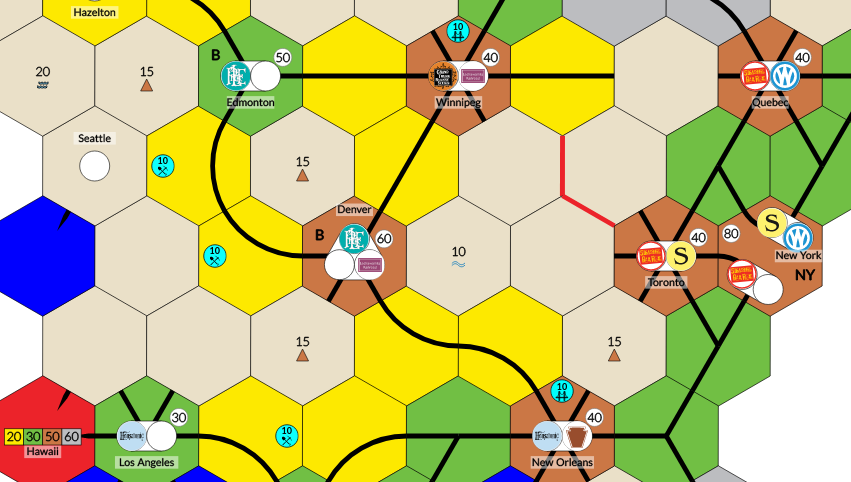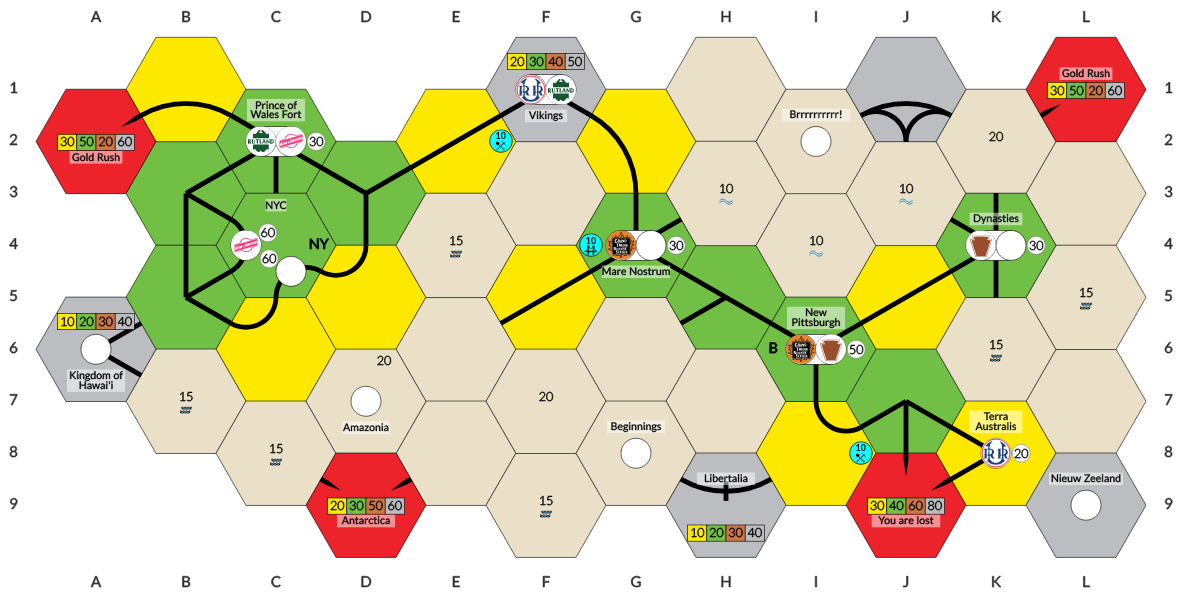Thoughts on 1817 variants
December 21, 2020
In this article, I wanted to share my thoughts on the two current 1817 variants, 1817NA and 1817WO. Both have been developed by Marc Voyer and interestingly I've helped playtest the both of them.
1817NA

1817NA is a shorter 1817 which supports a maximum of 6 players, features less starting capital, fewer trains, fewer privates and a smaller map. I really like this because it is perfect with 4 players and can really give you a great feel for the 1817 mechanics while taking around 6 hours to finish a game. In contrast with a full game of 1817 which lasts over 10 hours, this can be a great introduction to new players as well. Here are some extended notes:
- There are only three 2+ trains, so it is possible to hit the green phase in OR1.2 if any company converts and grabs the first 3T.
- The train rush to get the 3T is very real and it is quite possible that the 4T is popped by the game at the end of OR2.2.
- Klondike is a very interesting location offering a $140 payout but chances are that you will only be able to do it once. A good strategy would be to start in NYC and then merge with the Klondike company to be able to hit it 1 more time before triggering the green phase yourself. Also note that this works best with the mountain engineering private and might also benefit from a company operating out of Anchorage. Finally, the NYC company is great as a buffer for anyone thinking of shorting in SR2 as you could hopefully run out of NYC 2x for $180 in the green phase making those shorts look extremely risky.
- Denver is not as powerful as the 1817 Pittsburgh, however it can become a powerhouse if it works with another company with a lot of coal and can trigger the green phase in OR1.2. Moreover, in mid-game, Denver has a 3 B-tile run from Edmonton to Mexico city which is very lucrative (especially with coal on the route).
- Again, due to the fact that it is not as straightforward to execute on Denver, map development is more variable as compared to 1817. If the Denver tile is laid, then the mid-game can generate a lot of capital but if not, the game can stall as track development is fragmented and tight due to tokening.
- Note that due to the lack of a serious mid-game where money is generated, getting the first 5T is generally a game-winner but it also means that you would need to forego on the 4Ts. However, it also depends on how many trains your opponents are running and what their cash-flow looks like.
- Due to the steep jump in interest rates, a "short the world" event by a dying player can really flip the game around so one needs to necessarily keep a very close eye on bankrupting players. Somehow, most games that I won were those where the others did all the work in killing off the competition and I could thereafter sweep up the mess. In order to do this however, one needs to have a strong start with few (preferably only 1) loan(s) and a couple of 2+ trains. Thus, in a 4-player game, it is quite possible to win without owning any privates if they were bid up over fair face-value.
On the whole, if you can survive the 3T rush and make it out alive, you are in a good position. However, basic 18xx rules also matter, if your opponents are running more trains than you with a high interest rate, chances are that you're going to have to start shorting to shake things up.
1817WO

1817WO is even shorter than 1817NA, supports a maximum of 5 players, features lesser starting capital, even fewer trains, fewer privates and an even smaller map. While mathematically sound, I cannot recommend this one unfortunately due to the serious lack of mid-game money generation. In most of our playtests, we barely managed to hit the permanents and mostly just watched them zoom by. Here are some notes:
- This game plays best at 3-players and even then, due to the tight map, expect shenanigans.
- Again, the rush for the 3T is very real and expect 1 player to miss getting one. Moreover, it can also be likely that the 4T pops before the last of the 2T have run. However, similar to 1817NA, the person doing the dirty work ends up losing due to them being bogged down with the loans, whereas the person keeping loan space free is then able to mop up the floor.
- Due to the lack of mid-game capital, the 4T run for longer than they should and "short the world" scenarios are common. Beware of falling to the trap of share-redemption however.
All in all, bankruptcies are common in 1817WO and due to the low player counts, games are simply called. See above regarding the point about shenanigans. While I do enjoy the 1817 mechanics, I find 1817WO to be a cute puzzle but not really playable as a serious game. It could be useful as a teaching venture but even at that, the lack of capital generation in the mid-game will leave people scratching their heads as to how in the world could anyone ever afford a permanent train. Or perhaps, it could just be that our group is too aggressive with the trains and one would need a moratorium on train buying to let the game proceed smoothly. Definitely not happening with our group :).
Finally, while each of the variants does offer a shorter playtime which could be interesting for a teaching game, I would still recommend that beginners start with the original 1817 as learning basic concepts of valuation and private combinations are essential in order to be able to succeed with the variants as well in my opinion.